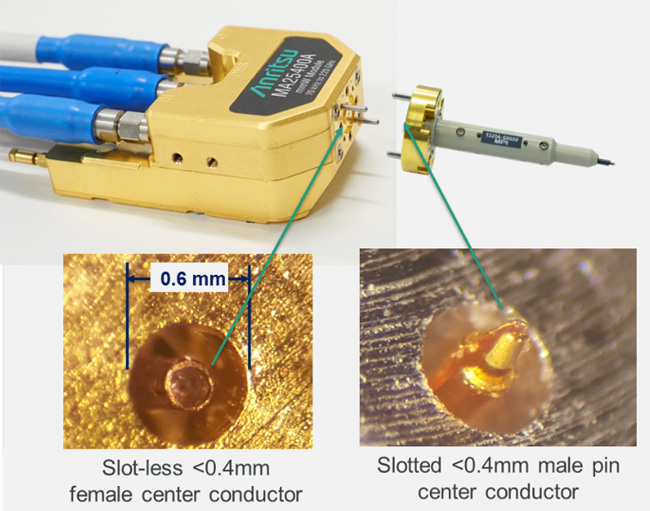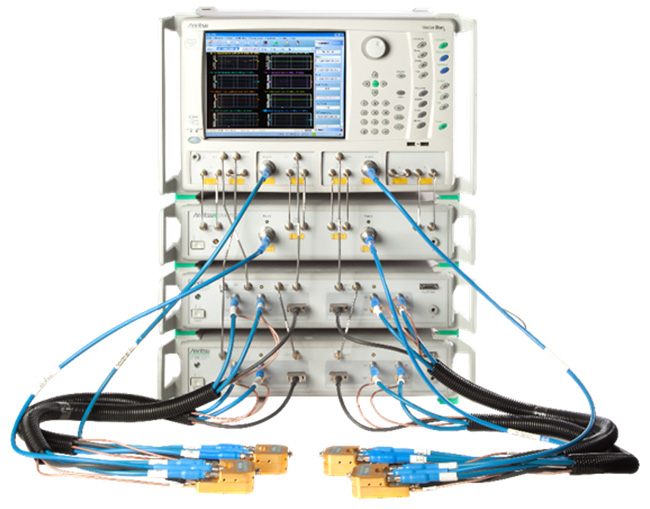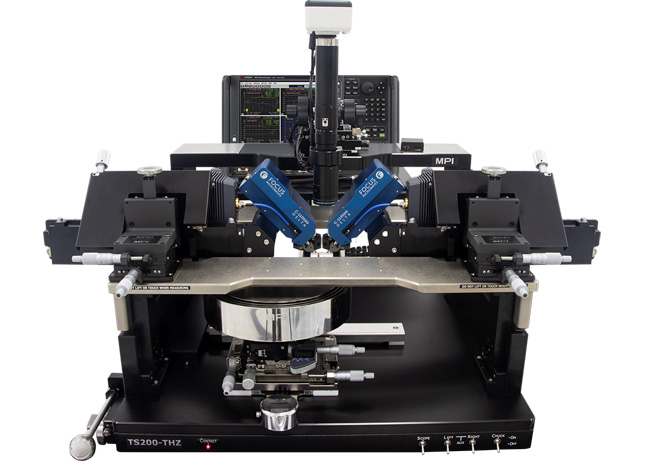With the roll out of 5G mmWave systems, automotive radar and higher frequency SATCOM systems, we thought it would be timely to survey the various test solutions available at these higher frequencies. We surveyed most of the companies involved in high frequency testing about their offerings in mmWave semiconductor testing. We received inputs from Anritsu, Focus, FormFactor, Keysight, Maury, NI, R&S, Roos and Teradyne. Below is a summary of the various offerings from the leaders in the industry.
Anritsu
During the design process of modern microwave and mmWave communication systems, designers must characterize devices (transistors, capacitors, inductors, etc.) over a broad range of frequencies from near DC to well beyond the operating frequencies of the design. The process of device characterization generates models used during circuit simulation and the accuracy of the model determines the accuracy of simulation and consequently, the chances for first turn success. An important element for model accuracy is characterization of devices well beyond the operating frequency of the circuit and, in many cases, characterization well beyond 110 GHz is desirable. An ultra-wide broadband VNA, such as the VectorStar™ ME7838G with 70 kHz to 220 GHz single-sweep capabilities, provides industry-leading measurements and enables optimal device characterization for accurate models and circuit simulations.
The Anritsu VectorStar ME7838 series broadband systems offer a number of unique attributes and performance capabilities through the use of Nonlinear Transmission Line (NLTL) technology in a unique proprietary design. The NLTL mmWave module provides source frequencies starting at 54 GHz that is coupled to the main transmission line through substrate couplers up to 110, 125, 145 and 220 GHz depending on the module model. The use of couplers ensures optimum raw directivity for optimum calibration and measurement stability. The Test and Reference harmonic sampler receivers are located next to the test port for accurate signal monitoring and operate from 30 to 220 GHz.
A critical aspect of high frequency broadband VNA systems is the connection to the device under test (DUT) measurement plane. For on wafer semiconductor measurements the DUT input is typically coplanar waveguide (CPW). Typically, connection from the VNA to the DUT is through a threaded coaxial connector such as the 1 mm connector. Connection to the DUT is therefore through the 1 mm transition inside a CPW probe and limited to the 110/125 GHz range.
To address the continuing requests for higher frequencies, Anritsu began development of the 0.6 mm coaxial connector for 220 GHz measurements. To avoid the negative consequences of connector thread wear at higher frequencies, the 0.6 mm coaxial connector was designed with an alternative guiding system for the connection to the CPW probe. The module to probe connection uses the UG-387 flange (see Figure 1), whose tolerances support precise alignment for 220 GHz mmWave measurements, and thus accurately pre-aligns the male/female center pin connection with excellent repeatability.

Figure 1. Anritsu NLTL mmWave module with DC coaxial connector mating of MPI probe using UG-387 interface.
Design of the probe body and tip was developed by MPI Corporation. The MPI probes, the TITAN T220, directly mates with the Anritsu MA25400A module and are available in 50, 75 and 100 micron pitches for support of a wide range of DUT pad connections.
As application frequencies migrate upward, differential receiver front-ends with wide dynamic range, high sensitivity and low noise floor are becoming critically important. A 4-port differential broadband VNA is therefore an important element during the design of microwave and mmWave communication systems. The modular concept of the VectorStar ME7838 series of broadband VNAs offers the opportunity to upgrade from 110 to 145 and 220 GHz through the use of appropriate frequency NLTL module. Likewise, a 2-port broadband VectorStar ME7838 system can be upgraded to 4-port configuration by adding additional test sets and modules. For example, the VectorStar ME7838D4 is a 4-port broadband system operating to 145 GHz with true differential measurement capability (see Figure 2). The industry has expressed a need for 220 GHz differential measurements and Anritsu will be collaborating with other industry leaders such as MPI during the development of a 220 GHz 4-port differential broadband VNA system.

Figure 2. VectorStar ME7838D4 4-port 145 GHz Broadband VNA.
Focus Microwave
Focus Microwaves and Keysight have collaborated to develop a turnkey solution which makes it possible to perform high frequency fundamental and harmonic load pull up to 110 GHz with great accuracy. Combined with Keysight’s very small footprint N5290A 110 GHz PNA-X, Focus Microwaves DELTA tuners offer a very simple and efficient system which elegantly integrates on wafer.
Key Features:
- On wafer load pull measurements up to 110 GHz
- Measure and optimize key nonlinear parameters
- Perform both scalar and vector load pull
- Focus Device Characterization Software to control instrumentation and collect data
- Measure multiple parameters over multi-octaves of frequency
mmWave on wafer load pull has always been a challenge for both test and design engineers as the inherent loss at high frequencies would limit the tuning and dynamic range on any load pull system. Keysight and Focus have collaborated to develop a turnkey solution which solves those problems making now possible to perform high frequency fundamental and harmonic load pull up to 110 GHz with great accuracy. Combined with Keysight’s very small footprint N5290A 110 GHz PNA-X, Focus Microwaves DELTA tuners offer a very simple and efficient system which elegantly integrates on wafer.
Focus Microwaves’ new DELTA series of electro-mechanical tuners is designed specifically for high frequency on wafer measurements. The tuner’s low profile allows it to be placed within the wafer perimeter and allows for a direct connection between the probe tip and the tuner, eliminating all possible insertion loss between the DUT and the tuner. This revolutionary new tuner design enables the engineer to achieve optimum tuning range, with a tuner whose footprint and weight has been dramatically reduced.
The PNA-X is a key component in this joint solution as it is the heart of the signal generation and analysis of the load pull solution. The PNA-X Series of microwave network analyzers are the culmination of Keysight Technologies, Inc. 40-year legacy of technical leadership and innovation in radio frequency (RF) network analysis. More than just a vector network analyzer, the PNA-X is the world’s most integrated and flexible microwave test engine for measuring active devices like amplifiers, mixers and frequency converters.
In this example, Focus has partnered not only with Keysight but MPI Corporation for the on wafer probing capability. The rigid MPI Engineering Probe Systems are the ideal choice for RF and mmW measurement applications. The compact footprint ideally fits to the requirements of integration with complex RF power and noise characterization systems. Accurate and back-lash free RF MicroPositioners provide precise positioning of the RF probes.
MPI explicitly designed and mmW dedicated, manual probe systems TS150-THZ, TS150-AIT & TS200-THZ (see Figure 3), the high-end mmwave MP80 MicroPositioner and the single-tube MPI SZ10 or MZ12 microscopes with unique combination of high magnification and long working distance Optics enable integrating the mmW, sub-mmW VNA frequency extenders and automated impedance tuners, closest possible to the DUT, for the shortest signal path and guaranteeing best possible measurement directivity and accuracy. MPI TITAN™ RF Probe Series with its unique design and MEMS manufactured tips provide unique visibility, low resistance and high consistency of the contact even on hard to probe Aluminum pads.

Figure 3. TS-200-THz test system.

